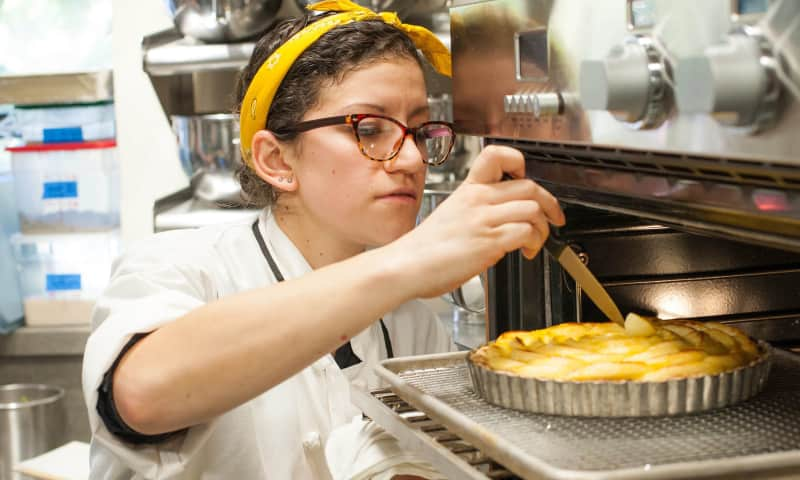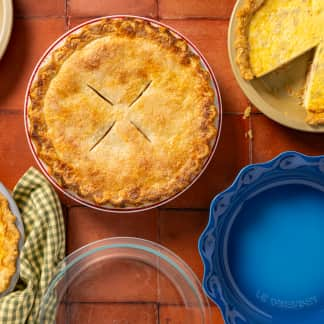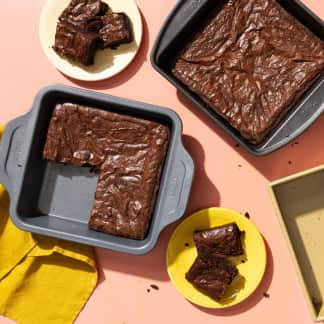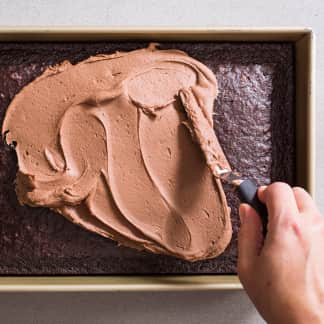Shallow, fluted tart pans can give a home baker’s quiche or fruit tart a professional look. But does it matter which tart pan you buy? To find out, we made a savory tomato tart with a pat-in-the-pan crust and a classic lemon tart with a pâte sucrée (traditional French sweet pastry) using five different models.
We considered only pans with removable bottoms—and if you’ve ever tried chiseling a delicate tart out of a solid pan, you understand why. Pans with removable bottoms allow the baker to remove the rim before sliding the tart off the disk base and onto a serving plate. As for nonstick tart pans, our past tests showed that their slick surfaces were a slight disadvantage when pressing dough into the crevices of the pan because the dough slumped down and didn’t adhere as well. But with formulas for nonstick coatings always changing, we decided to reconsider nonstick tart pans to see if new models would perform better than their older cousins. We ended up with three nonstick steel pans and two traditional-finish pans (one made of tinned steel and one aluminum).
As we rolled pastry dough into the pans, we were in for a surprise: Whether the pans were nonstick or not, they were all equally fine to work with, and the doughs more or less stayed put and didn’t slump. The traditional-finish pans had a tacky surface that was a bit easier to use, really holding on to the dough as we pressed it in place. But in the end, none of the pans presented problems for rolling or pressing dough into the fluted grooves.
Not only were the nonstick pans not a problem, but there were several areas—browning and release—where they performed better than traditional-finish pans. A good tart pan should give you golden, even browning—any dark-brown or too-pale spots mar presentation as well as texture and flavor. For even, golden browning on both savory and sweet crusts, pans with dark nonstick coatings outperformed the shiny, lighter finishes of the traditional-finish pans. This makes sense because darker pans hold heat better.
Though removable sides make removing a tart from the pan easier, the final shimmy of the tart off the disk bottom and onto the serving plate takes some finesse. Here the nonstick coating on three of the pans helped reduce the potential for tart breakage. The sticky finish on the aluminum pan, which had been a small asset when rolling out the dough, made removing the tart from the base a little harder than it had to be (although it still released adequately).
The wavy edges on a tart pan’s rim, called flutes, give the finished tart its professional, polished appearance. As the tarts cooled, we noticed that the one that was baked in a pan with sharply fluted sides looked best. The tarts we baked in two pans that had wide, shallow flutes were less impressive, lacking the crisp detail of our winner. As for durability, although we would never suggest using a knife to cut slices directly on a tart pan (we always remove the bottom first), we held our breath and made multiple slashes on the pans with a paring knife to see how they held up. All the pans withstood this punishment at least fairly well and were fine to use afterward.
With all that butter, tart crusts sure leave a greasy mess to clean up. Only one pan was dishwasher-safe; the rest needed a good scrubbing to get the grease out of the grooves. Our favorite pan, the Matfer Steel Non-Stick Fluted Tart Mold is hand-wash only, but it excelled in all other respects, flawlessly releasing sweet and savory crusts alike with even browning and crisp, polished edges.
The Tests
- Roll and press Sweet Tart Pastry dough into pans
- Pat and press Torta di Pomodoro (Tomato Tart) savory dough into pans
- Blind-bake dough
- Fill and finish baking tarts in pans
- Lightly score pan bottoms with paring knife
- Wash pans 10 times per manufacturer’s recommendation (by hand or in dishwasher)
How We Rated
- Browning: The degree of browning, underbrowning, and overbrowning present
- Tart Appearance/Edges: How crisp and professional the edges of the tart appeared after final baking
- Release: How easy it was to slide the tart from the pan’s bottom onto a serving plate
- Dark finish for even browning
- Sharp fluted edges that make tarts look crisp and professional
- Nonstick coatings that promote flawless release











